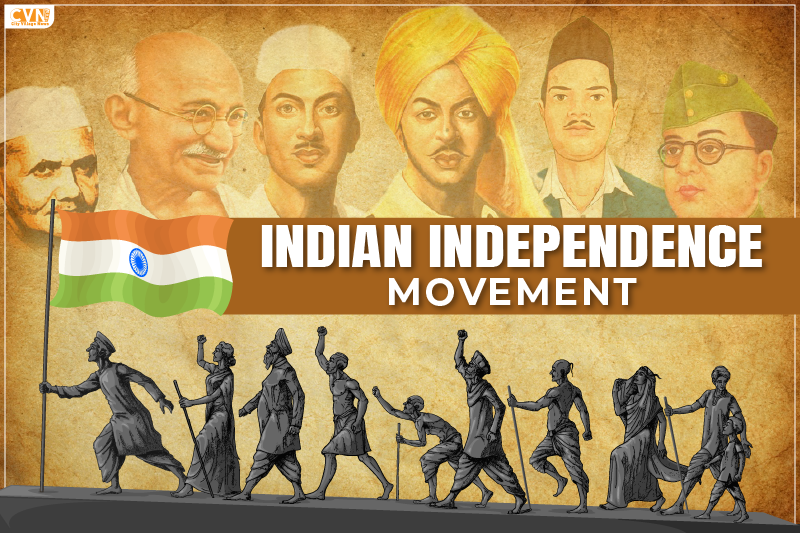It’s been more than 7 decades since India gained independence from British rule. This was a result of countless political and social initiatives known as the Indian Independence Movement. This was characterized by numerous hardships, many sacrifices, and important occasions that helped to form modern-day India. An India where we breathe freely. But the majority of the youth today isn’t aware of what happened during this movement. This is a thorough rundown of all the important aspects of this historic conflict.
Early Resistance
India started to rebel against British authority in the early 1800s. Ishwar Chandra Vidyasagar and Raja Ram Mohan Roy were among the early leaders who fought against colonial practices and promoted social reform. Their goals were to advance education and bring back Indian culture. During this time, people were more conscious of how badly British policies affected Indian society.
Formation of Political Organizations
British politician Allan Octavian Hume established the Indian National Congress (INC) in 1885 with the original intention of promoting communication between the British administration and Indian elites. But as the fight for independence progressed, the INC rose to prominence. The All India Muslim League was founded in 1906 to advocate for Muslim concerns and subsequently emerged as a major force in the independence movement.
The Early 20th Century and Gandhi Ji’s Role
An important juncture in the Indian Independence Movement was the early 1900s. Mahatma Gandhi gained fame as a leader thanks to his philosophy of nonviolent resistance, or Satyagraha. Millions of Indians were inspired by his leadership to fight for their independence through nonviolent means. During this time, important events included:
The Non-Cooperation Movement (1920-1922): During this, Gandhi advocated for a boycott of British companies and products. This movement encouraged Indians to be self-sufficient in an effort to undermine British rule.
The Salt March (1930): Gandhi organized a 240-mile march to produce salt beside the Arabian Sea, in defiance of British legislation that levied a tax on salt. India’s battle gained international attention as a result of this act of civil disobedience.
The Quit India Movement (1942): Gandhi started this movement to demand an end to British rule during World War II. The severe British response resulted in a large-scale arrest and repression.
Also Read: Places to Visit for Independence Day in India
World War II and the Road to Independence
The Second World War had a big influence on the Indian Independence movement. There was a great deal of unhappiness about the British decision to send India into the war without first consulting Indian leaders. Independence demands grew stronger in the years following World War II, and the British administration realized reform was necessary.
The 1945 Labour government that was elected to power in Britain was more sympathetic to Indian ambitions. Negotiations for Indian Independence began in earnest. Important discussions included:
The Cripps Mission (1942): Leaders in India were in talks for negotiations with Sir Stafford Cripps. Even though the INC rejected his suggestions, they paved the way for additional talks.
The Simla Conference (1945): The purpose of this meeting between political representatives from India and Britain was to settle issues and open the door to independence.
Partition and Independence
Intense talks and rising tensions between communities characterized the last years leading up to independence. Pakistan was established as a result of the All India Muslim League’s and its leader Muhammad Ali Jinnah’s demands for a separate Muslim state. Important events comprised:
The Mountbatten Plan (1947): The final British Viceroy of India, Lord Louis Mountbatten, put up a proposal to split British India into two independent dominions of India and Pakistan. The Muslim League and the INC agreed to this plan.
Independence and Partition (August 15, 1947): On August 15, 1947, India declared its independence and split into Pakistan and India. Mass migrations, intercommunal violence, and a high death toll were caused by the division.
The Indian Independence Movement was a significant period in Indian history. It was distinguished by a synthesis of grassroots activity, political strategy, and visionary leadership. India’s democratic institutions and its continued participation in international debates concerning justice and freedom are testaments to the movement’s legacy. Gaining knowledge of this movement might help one better understand the challenges and victories that India faced on its way to becoming an independent country.
| Disclaimer: City Village News claims no credit for the images featured on its blog site. All the visual content is copyrighted to its respective owners only. We mention the source name of the picture whenever possible and found. However, please get in touch with us if we miss acknowledging the owner’s source. In case the owners don’t want us to use their images, we will remove them promptly. We believe in providing proper attribution to the original author, artist, and photographer. |

